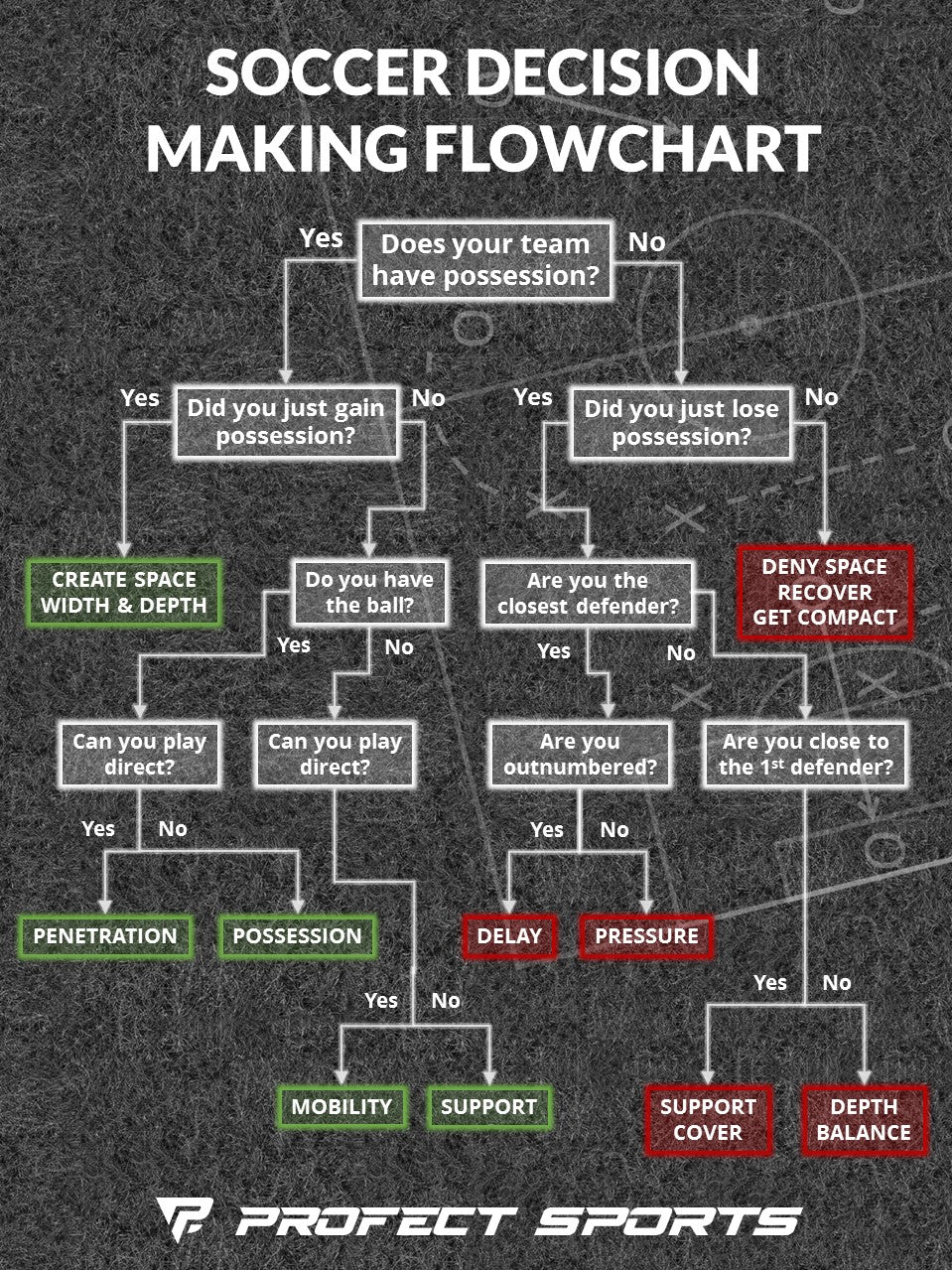Youth Soccer Decision Making Tactics
“Help!”
“My team is caught out of position again!”
Don’t let this be you…
Your players need direction.
Do you know how to coach them in every situation?
Soccer is a game that requires quick decisions.
The ball is always moving and different situations call for different actions.
Use this flowchart to help your players understand what to do in every scenario.
Download the PDF in full color or the white printable version.

Download the PDF in full color or the white printable version.
The Principles of Play for Soccer
Breaking the game down to the basics, there are only a handful of actions for both attacking and defending.
As a general rule, your goal as an attacker is to:
- Keep possession of the ball.
- Move the ball forward.
- Create opportunities to score.
As a defender, your role is the opposite:
- Stop the other team from creating opportunities to score.
- Keep the other team from getting into attacking position.
- Get possession of the ball.
Attacking Principles of Play
When your team has the ball you are on the attacking team.
Create Space, Width and Depth
When you have just regained possession of the ball, your first action should be to create space. As part of the transition from defense to attack, your team should spread the field, both wide and deep, to open holes in the defense.
Penetration
Playing direct is aggressively moving the ball forward. When there are gaps between or and open space behind the defenders, move the ball forward and try to get into scoring position.
Possession
The opposite of playing direct would be keeping the ball, short passing, and patiently waiting for the opportunity to attack. The goal of possession is to find a way to penetrate and exploit the defense by forcing them to move out of position.
Mobility
Mobility is changing position and creating movement to support the play. The attacking players that don’t have the ball should be creating space on and off the ball. In this case, the attacker would be looking for space behind the defenders.
Support
If the attacking team has possession, but does not have an opportunity to penetrate, the supporting players should spread the field to support the player with the ball. This can be ahead, to the side, or behind the ball to create passing lanes while spreading the field.
Defending Principles of Play
When the other team has the ball you are on the defending team.
Deny Space, Recover and Get Compact
When your team is on defense, you want to deny space, recover, and get compact. Take away space for the other team to play in and close any gaps between the ball and your goal. Force the attacking team into situations where they will turn the ball over to you.
Delay
After losing possession, if the closest defender, is outnumbered, your best action is to delay. The purpose of delay is to stop the other team from playing forwards by slowing down the attack. You want to allow your team to reshape and gets back into position.
Pressure
If the closest defender is not outnumbered, he should immediately put pressure on the ball to attempt to win the ball back quickly.
Support and Cover
If you’re not the closest defender, but still near the ball, you want to be providing tight support by covering any open attackers. Without any other players to pass to, the attacking team will end up losing possession.
Depth and Balance
For the defenders that are not near the ball, spread out and get into position between the ball and the goal removing any opportunities for the attackers to penetrate. Balance provides additional defensive support and puts your team in position to react in case the ball moves across the field.
Quick Decisions
The key to these principles is transitioning quickly and efficiently. Along with these principles, transition from attack to defense and back again should be practiced until every player on the team is comfortable and knows what to do.
While on the attack, it’s important to be creative and catch the defenders by surprise. The opposite is true on defense. If your team is staying disciplined and patiently maintaining position, the attacking team won’t have any opportunities to move the ball forward.
As always, communication is critical. The coach must be directing the team and the players need to talk and gesture to stay organized and avoid confusion.
Share This!
Please share this with other coaches!
We are a community working toward the same goal – player development!
If you haven’t already, feel free to download the PDF in full color or the white printable version.
Bring it with you to practice and hand it out to your team.


